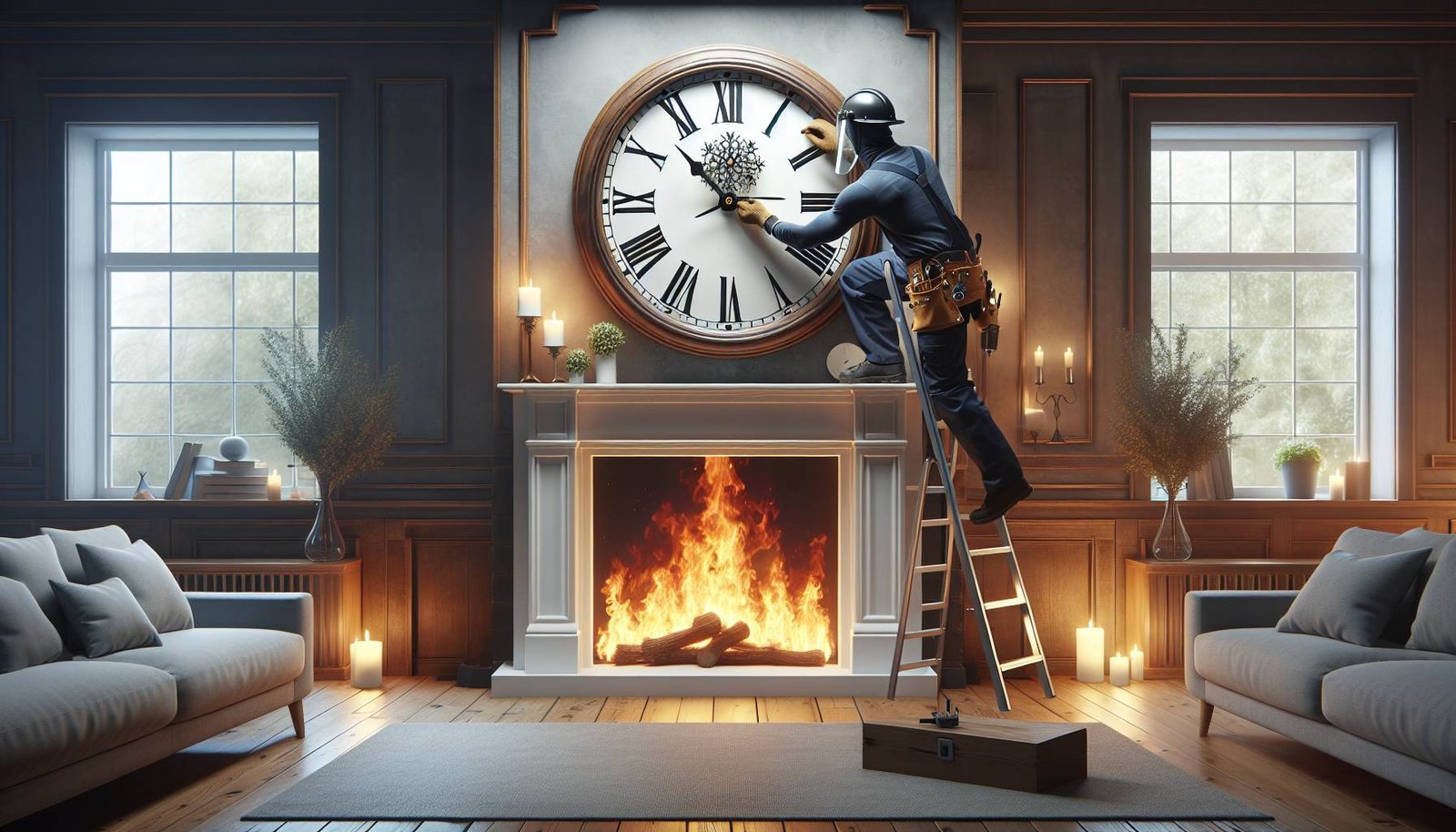When installing a wall clock above a fireplace, ensure you take the following safety precautions:
-
Material Selection: Choose a clock made of materials that can withstand heat, such as metal or ceramic.
-
Secure Mounting: Use appropriate anchors and supports for the weight of the clock, and ensure it is securely attached to the wall, away from any potential heat damage.
-
Safe Distance: Keep at least 12 inches of space between the bottom of the clock and the top of the fireplace mantel to prevent the clock from heat exposure.
-
Heat Monitoring: Regularly check that the area around the clock does not exceed the material’s heat resistance threshold.
-
Maintenance: Set up a cleaning and inspection routine to address any soot buildup and check for any signs of wear or damage due to heat exposure.
The quaint charm of a wall clock above a fireplace is an aesthetic many homeowners aspire to. Yet, the merge of functional timekeeping and cozy firelit evenings comes with the need for vigilance. In this discussion, we explore the safety precautions necessary when installing a wall clock above a fireplace.
Understanding the Risks
Awareness of potential hazards can significantly mitigate risks associated with hanging a wall clock above a hearth.
Heat Damage
Continuous exposure to high temperatures can adversely affect wall clocks, especially those made from sensitive materials. Heat can cause warping, discolouration, and in severe cases, melting.
Smoke and Soot
Over time, smoke can deposit soot on the clock surface, leading to staining and the necessity for frequent cleaning, which may not always be straightforward depending on the clock’s design and material.
Falling Hazards
An improperly secured wall clock is a safety hazard, potentially falling and causing injury or damage to the fireplace itself.
Pre-installation Safety Checks
Before hammer and nail, certain checks and balances guarantee a safer installation process.
Choose the Right Wall Clock
Opt for materials known for their heat resistance.
- Metal: Often resilient to high temperatures, maintaining structure and appearance.
- Ceramic: Less likely to absorb soot, easy to clean, and heat tolerant.
- Heat-resistant plastics: Some modern plastics are designed to withstand high temperatures, but be sure to check the manufacturer’s specifications.
Assessing Your Fireplace Mantel
Examine the mantel for:
- Structural integrity – ensure it can bear the weight of the clock.
- Temperature – use a thermometer to measure how much heat reaches the area above the mantel.
Tools and Equipment
Employ non-flammable installation tools, and do not forget a stud finder to secure the clock safely to the wall.
Installation Process
A vigilant installation is paramount to both the clock’s longevity and household safety.
Measuring and Marking
Carefully measure the space above your fireplace, keeping in mind to leave adequate room between the clock and the fireplace to reduce heat exposure.
Securing the Clock
Heavier clocks may require wall anchors and supports. Ensure these are appropriately rated for the weight of your clock.
Safety Distance
| Distance from Heat Source | Minimum Distance |
|---|---|
| Directly above the mantel | 12 inches |
| Above a stone surround | 6 inches |
It’s a rule of thumb to allow at least 12 inches of space between the bottom of the clock and the top of the fireplace mantel.
Final Checks
After installation, do a thorough inspection to confirm stability and the absence of any loose parts.
Read More:
- The Ultimate Guide to Packing a Large Wall Clock for a Long-Distance Move
- Protecting Your Timepiece: How to Prevent a Wall Clock from Fading in Direct Sunlight
Maintenance Tips
Post-installation care is equally as important to ensure the clock’s and your home’s safety.
Regular Cleaning
Adopt a cleaning schedule to keep the clock free from soot. Regular dusting and the use of soot removers can be particularly effective.
Heat Monitoring
Periodically check that the temperature around the clock remains below the material’s heat resistance threshold.
Inspection Schedule
Plan to inspect the clock’s stability and battery (if applicable) every six months to ensure continued safe operation.
Common Mistakes to Avoid
When installing a wall clock above a fireplace, several pitfalls should be dodged.
Ignoring Manufacturer’s Instructions
Always adhere to the guidelines provided by the clock manufacturer for installation and maintenance.
Choosing Appearance Over Functionality
Prioritize materials and designs that offer durability and safety over purely aesthetic considerations.
Neglecting Regular Maintenance
Inattention to regular cleaning and inspections can lead to the accumulation of soot and potential heat damage.
Conclusion
Installing a wall clock above a fireplace is a decorative decision that marries form with function. Yet it demands cautious execution. Remember safety first: choose the right materials, use the proper tools, maintain a safe distance from the heat source, and keep a maintenance schedule. Follow this guide, and you’ll ensure that your charming timepiece stands the test of time without compromising on safety or design.

